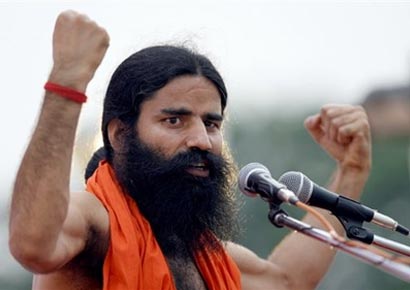 New Delhi, Aug 9: Yoga guru Baba Ramdev called on the Centre to adopt an eye for an eye approach and kill at least 50 Pakistani soldiers in retaliation for the five Indian soldiers killed in Poonch on Tuesday.
New Delhi, Aug 9: Yoga guru Baba Ramdev called on the Centre to adopt an eye for an eye approach and kill at least 50 Pakistani soldiers in retaliation for the five Indian soldiers killed in Poonch on Tuesday.
“India should retaliate with killing at least 50 Pakistani troops, against the five Indian soldiers that they have killed. And then, the Congress should tell the nation that this is the action that the government has taken. Statements do nothing, especially those filled with cowardice,” Baba Ramdev said.
Criticizing the UPA-led Central Government, Baba Ramdev said that its reaction damages the pride and respect of the nation
“The time for statements has gone, it is now time for action. The present Central Government is zero in terms of taking action. But by giving wrong statements, the Central Government is risking the country`s security, respect and pride. It looks like the country is not intact in the hands of the present Central Government. They cannot protect the country`s respect and pride,” Ramdev said.
While Pakistan has denied the involvement of its troops in the incident, Defence Minister A.K. Antony on Wednesday said that the intruders who killed the five Indian soldiers were "terrorists along with persons dressed in Pakistan Army uniform.
Antony`s Wednesday statement had attracted a lot of flak, as it has contradicted the Indian Army`s account, which said that the perpetrators were "soldiers from the Pakistan Army." The BJP-led opposition had accused the Central Government of "giving the Pakistan Army a clean chit.
Antony in his updated statement to both Houses of Parliament on Thursday said, "It is now clear that Specialist Forces of the Pakistan Army were involved in the attack. Those in Pakistan who are responsible for this tragedy, should not go unpunished. Our restraint should not be taken for granted.
"We all know that nothing happens from the Pakistan side of the LoC without the support, assistance, facilitation and often, direct involvement of the Pakistan Army. Pakistan must take steps to punish those responsible for the attack. Pakistan should also dismantle all terrorist apparatus on its soil," said Antony
He also warned that attacks such as this will have consequences not only on the Line of Control (LoC), but also naturally on the (future) relationship with Pakistan
He said that the Indian Government would not stand by the wayside and allow the sanctity of the LoC to be violated time and again
"The capacity of our armed forces, the resolve of the government to uphold the sanctity of the LoC should not be doubted," Antony added
Commenting on Defence Minister A.K. Antony`s statements made in Parliament on Wednesday and Thursday, Baba Ramdev said that the shifting statements are a matter of shame
“The shifting statements made by the Defence Minister not only disrespects the martyrdom of five soldiers, but it also impacts crores of people of India. It is not the question of only the five jawans, but is also a matter of national unity and integrity. …The shifting statements are a matter of shame shows cowardice, Ramdev said
Ramdev also accused the Congress of not having the best interest of the country in mind saying, “The Congress has always operated in a way that damages the morale of the Indian Army. It seems to me that the Congress` loyalties are not with India but with Pakistan.”
Though his updated statement has been welcomed by the BJP, the opposition party has demanded that Parliamentary discussions focus on the incident and have asked for a suspension of talks with Pakistan.





Comments
Add new comment